A different world
2009 Spa Six Hours report
Author & photography
- Mattijs Diepraam
Date
- October 1, 2009
Related articles
- Spa - The Transit-and-trailer revival, 2006 Spa Six Hours report, by Mattijs Diepraam
- Spa - Inhaling enthusiasm, 2008 Spa Six Hours report, by Mattijs Diepraam
- Spa - Rain, beer and champagne, 2010 Spa Six Hours report, by Mattijs Diepraam/Frank van de Velde
- Spa - Agreeable circumstances, 2011 Spa Six Hours report, by Mattijs Diepraam/Frank van de Velde
- Spa - Frantic action under the sun, 2012 Spa Classic report, by Mattijs Diepraam
- Spa - Taking on the GT40s, 2013 Spa Six Hours report, by Mattijs Diepraam
- Spa - Tropical Spa… but in the rainy season!, 2014 Spa Six Hours report, by Mattijs Diepraam
- Spa - An old-fashioned one, 2015 Spa Six Hours report, by Mattijs Diepraam
- Spa - Before the rain, 2016 Spa Six Hours report, by Mattijs Diepraam
- Spa - Nightmare morphs into fairytale, 2017 Spa Six Hours report, by Mattijs Diepraam
- Spa - That five-and-a-half hour sprint race on a Saturday night…, 2018 Spa Six Hours report, by Mattijs Diepraam
- Spa - Slippery when wet, 2019 Spa Six Hours report, by Mattijs Diepraam
- Spa - Endurance revival, 2021 Spa Six Hours report, by Mattijs Diepraam
- Spa - The Dutch double up, 2022 Spa Six Hours report, by Mattijs Diepraam
- Spa - Nightmares and fairytales, 2023 Spa Six Hours report, by Mattijs Diepraam
- Spa - Original victory, 2025 Spa Six Hours report, by Mattijs Diepraam
Who?Shaun Lynn/Andrew Haddon What?Ford GT40 Where?Spa When?2009 Spa Six Hours (September 26, 2009) |
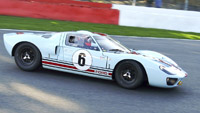 |
Why?
They’re two different worlds separated by a week. The Goodwood Revival brings a glamourous, polished, highly nostalgic version of days gone by, the Spa Six Hours is probably closer to what it was really like. Still it’s attracting ever more stars in its own right.
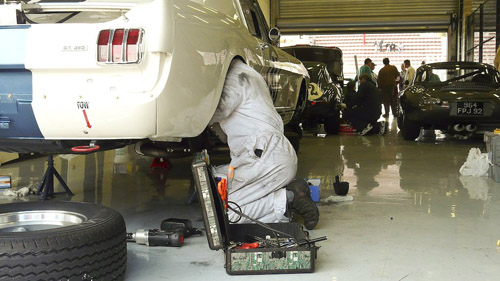
There is still no comparison to the absolute crowd puller that the Revival has become, but the Spa Six Hours stopped being an oversized overseas British club meeting some years ago. Today, the entry reads as a who’s who of international historic racing. The previous weekend at Goodwood, it was dubbed “the best historic event on continental Europe”. While those words won’t come as a surprise since they were spoken by Ian Titchmarsh, who is the commentator for both events, you can’t really fault them. They certainly hold true for the headline race, the invitational Six Hours. It’s effectively an entire season in one race, and the cars taking part in it are really fighting a war of endurance. Not just against their fellow competitors, but especially against time and themselves. As one team manager said: “You don’t normally do this to your car – but that’s what the challenge is all about!” The event allows you to really be a part of the excitement, since access to the paddock and the pit lane is free to all ticket holders. Only the grid and the areas at the side of the track are privileged to the press.
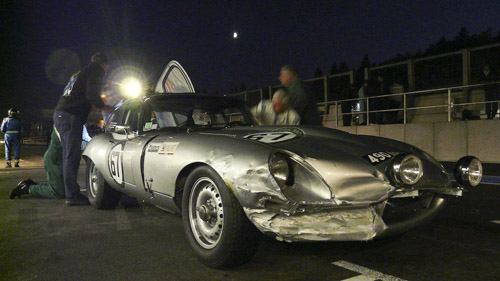
More pictures of the pits and the grid
The Six Hour-winning car – Lanzante’s Ford GT40 driven by Shaun Lynn and Andrew Haddon – was a prime example of a car that hang on by its teeth. Fast but fragile, it started from the pitlane after suffering problems in practice but steadily worked its way to the front. In the final hour however, by now a lap ahead of the rest, it had to slow its pace considerably. At La Source, you could hear the car almost coast through, as it was dropping almost ten seconds a lap. But with three-minute laps at Spa it could afford to. The second-place AC Cobra of Rob Hall and David Hart, driven in the final stint by Jeroen Bleekemolen, duly took its lap back and closed to within 1m40, but the Ford hung on. “Another ten minutes and the car would have collapsed”, Shaun Lynn admitted to a rival team owner. But no matter, the now two-time Six Hour victor would have taken the win in any way possible, such is its stature by now. Hart’s British crew chief rued that it wasn’t the Spa Seven Hours, but was still pleased that his Cobra was able to hound a GT40. He was chuffed about Bleekemolen’s contribution too. It was the first time Jeroen sat in the car but he immediately approached the fastest times in the race. So what was it like to have a professional driver in the car? “You said it right there, he’s a professional. His very first question was how he wanted me to drive the car. In the end, we gave him free rein. Just go for it, see where you end up. He did brilliantly.” Hart concurred: “He did a super job and enjoyed it immensely.”
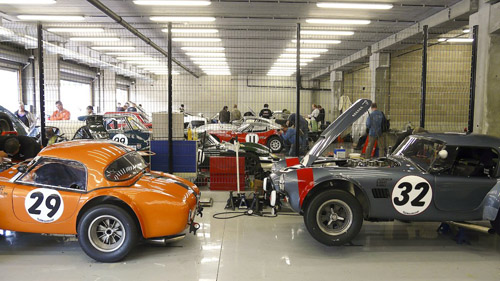
Bleekemolen Jr was probably the biggest name brought in to secure a win in the main race, which is testimony to the growing importance of the Six Hours. Another star driver was Maserati GT racer Vincent Vosse bolstering the Hugenholtz/Herzog Shelby Mustang line-up as a last-minute replacement to Jochen Mass. Dutch GT4 racers Allard Kalff and Michiel Campagne brought a Chevrolet Grand Sport to share with former Grand Prix driver Michael Bleekemolen. Double European GT4 champion Eric De Doncker was part of a Belgian Cobra crew. They all combined with top drivers recently having made the transition to historic racing, such as Germany’s Frank Stippler. ‘Stippy’ already shone on his debut at Goodwood and drove the wheels off his E-type at Spa as well. Another interesting face was 2004 Euro 3000 champion Nicky Pastorelli sharing David Hart's mighty Ferrari 512M in the big-banger sportscar race. IndyCar star Robert Doornbos was a surprise guest to the Dutch teams, and we expect others of his calibre to come and take a look as well in the coming years.

More pictures of people on and off the track
The other races were certainly enjoyable as well. Apart from the two Grand Prix Masters dashes and the HSCC race, most other races play the endurance card when compared to the sprint formats at Goodwood. This allows races to evolve, while the mandatory driver changes – or at least pit stops – throw in an added dimension. The longer races give drivers the opportunity to bide their time and pounce in the final stages of the race. That patience was lacking in the 30-minute HSCC blast that almost inevitably ran under the safety car for almost half its allotted time. Cars were flying off everywhere – unnoticed to your reporter who was sitting on the outside of Blanchimont at the time, all alone, but under the care of the marshals at post 23. “C’est le carnage! C’est le carnage!” the communications marshal shouted to her unbelieving colleagues, and it wasn’t long before we saw the wrecks being transported past us on their way back to the paddock.
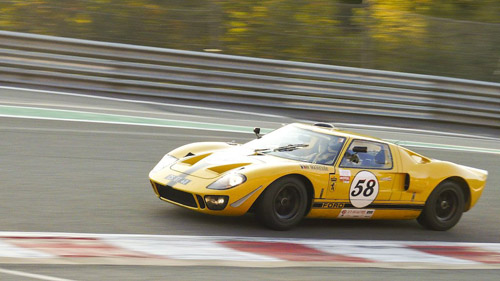
More pictures of the Saturday and Sunday track action
And then there’s Spa itself. Its atmosphere fits the bill perfectly. Almost an enclave of motorsport in between the hills of the Ardennes, the circuit and its basic facilities easily allow you to time-travel to sometime in the seventies when motor racing still found itself halfway between amateurism and professionalism. Walking around the paddock you were bound to surrender to the charm of an endless variety of cars seemingly willfully scattered across their allotted spaces, and the people working away at them in the midst of a bewildering array of tools, parts and refreshments. So even when the event doesn’t blatantly attempt to be nostalgic, you will nonetheless be prone to romantic views of the teams’ nomadic existence.
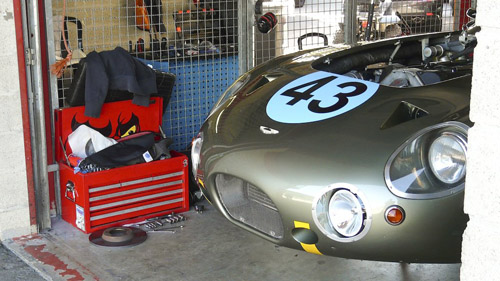
More paddock atmosphere
Not that there’s anything wrong with romanticism. If you’re in the mood you will try to drown yourself in a continuing stream of opportunities at having a closer look at the cars’ most intriguiging details from every possible angle and endulge in their engineering beauty – or idiosyncracy.
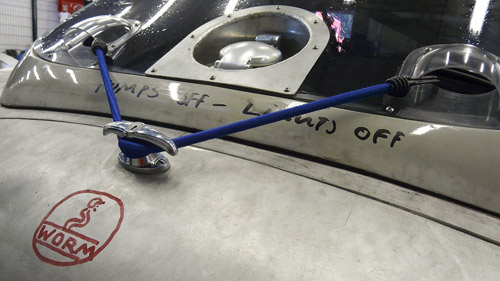
More Spa Six Hours detail
A walk around the entire circuit is highly advisable. Standing at the top of Eau Rouge, into the Raidillon, is an amazing experience during any kind of motor race. Since the attendance is still surprisingly low – certainly compared to the Revival – you will soon find yourself all alone walking the Kemmel while the big-banger prototypes come thundering by. The les Combes-to-Rivage sequence shows how the cars behave under braking and in slow corners. And then, after you’ve taken the pedestrian tunnel to Bruxelles, the Spa speed bowl suddenly opens up to you in all its glory. From here, you can see the cars approaching from Rivage before they make their way to Pouhon, that massive ever-continuing left-hander. The outside of Pouhon is the place where you will really appreciate what a big, big corner this is. The esses between Pouhon and Stavelot make for another excellent vantage point, on the entry as well the exit. And why not end your visit at Blanchimont? It’s one of the best places to spend a ‘quiet’ Sunday afternoon, listening to the birds, the bees and two dozen angry and flat-out Cosworth DFVs…
